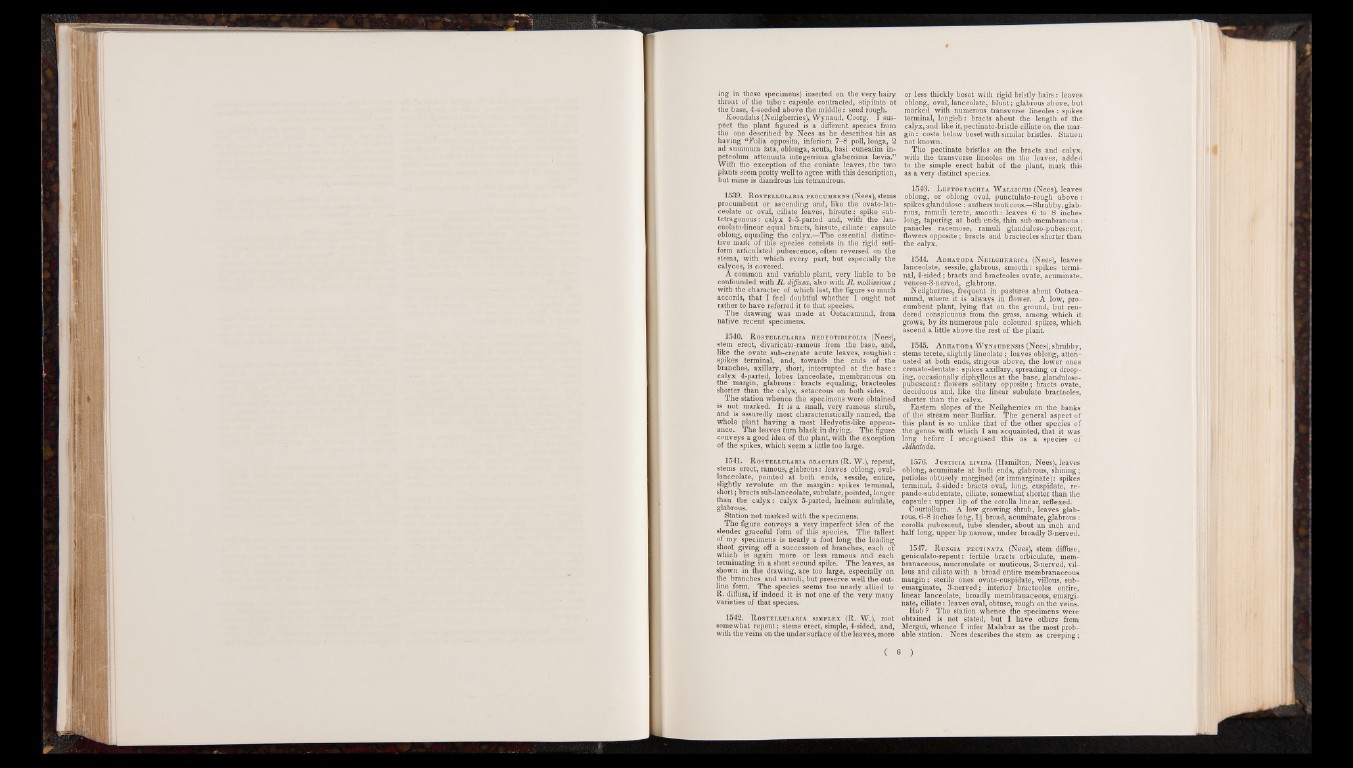
ing in these specimens) inserted on the very hairy
throat of the tube: capsule contracted, stipitate at
the base, 4-seeded above the middle: seed rough.
Koondahs (Neilgherries), Wynaud, Coorg. I suspect
the plant figured is a different species from
the one described by Nees as he describes his as
having “Folia opposita, inferiora 7 -8 poll, longa, 2
ad summum lata, oblonga, acuta, basi cuneatim in-
peteolum attenuuta integerrima glaberrima laevia.”
With the exception of the cuniate leaves, the two
plants seem pretty well to agree with this description,
but mine is diandrous his tetrandrous.
1539. Rostellularia procumbens (Nees), stems
procumbent or ascending and, like the ovato-lan-
ceolate or oval, ciliate leaves, hirsute: spike sub-
tetragonous: calyx 4-5-parted and, with the lan-
ceolato-linear equal bracts, hirsute, ciliate: capsule
oblong, equaling the calyx.—The essential distinctive
mark of this species consists in the rigid seti-
form articulated pubescence, often reversed on the
stems, with which every part, but especially the
calyces, is covered.
A common and variable plant, very liable to be
confounded with 22. diffusa, also with 22. mollissima;
with the character of which last, the figure so much
accords, that I feel doubtful whether 1 ought not
rather to have referred it to that species.
The drawing was made at Ootacamund, from
native recent specimens.
1540. R ostellularia hedyotidifolia (Nees),
stem erect, divaricato-ramous from the base, and,
like the ovate sub-crenate acute leaves, roughish:
spikes terminal, and, towards the ends of the
branches, axillary, short, interrupted at the base:
calyx 4-parted, lobes lanceolate, membranous on.
the margin, glabrous: bracts equaling, bracteoles
shorter than the calyx, setaceous on both sides.
The station whence the specimens were obtained
is not marked. It is a small, very ramous shrub,
and is assuredly most characteristically named, the
whole plant having a most Hedyotis-like appearance.
The leaves turn black in drying. The figure
conveys a good idea of the plant, with the exception
o f the spikes, which seem a little too large.
1541. R ostellularia gracilis (R. W.), repent,
stems erect, ramous, glabrous: leaves oblong, oval-
lanceolate, pointed at both ends, sessile, entire,
slightly revolute on the margin: spikes terminal,
short; bracts sub-lanceolate, subulate, pointed, longer
than the calyx: calyx 5-parted, lacineae subulate,
glabrous.
Station not marked with the specimens.
The figure conveys a very imperfect idea of the
slender graceful form of this species. The tallest
of my specimens is nearly a foot long the leading
shoot giving off a succession of branches, each of
which is again more or less ramous and each
terminating in a short secund spike. The leaves, as
shown in the drawing, are too large, especially on
the branches and ramuli, but preserve well the outline
form. The species seems too nearly allied to
R. diffusa, if indeed it is not one of the very many
varieties of that species.
1542. Rostellularia simplex (R. W.), root
somewhat repent; stems erect, simple, 4-sidea, and,
with the veins on the under surface of the leaves, more
or less thickly beset with rigid bristly hairs: leaves
oblong, oval, lanceolate, blunt; glabrous above, but
marked with-numerous transverse lineoles: spikes
terminal, longish: bracts about the length of the-
calyx, and like it, pectinato-bristle ciliate on the margin
: costa below beset with similar bristles. Station
not known.
The pectinate bristles on the bracts and calyx,
with the transverse lineoles on the leaves, added
to the simple erect habit of the plant, mark this
as a very distinct species.
1543. Leptostachya Wallichii (Nees), leaves
oblong, or oblong oval, punctulato-rough above:
spikes glandulose: anthers muticous.—Shrubby, glabrous,
ramuli terete, smooth: leaves 6 to 8 inches
long, tapering at both ends, thin sub-membranous:
panicles racemose, ramuli glanduloso-pubescent,
flowers opposite; bracts and bracteoles shorter than
the calyx.
1544. Adhatoda Neilgherrica (Nees), leaves
lanceolate, sessile, glabrous, smooth: spikes terminal,
4-sided; bracts and bracteoles ovate, acuminate,
venoso-3-nerved, glabrous.
Neilgherries, frequent in pastures about Ootacamund,
where it is always in flower. A low, procumbent
plant, lying flat on the ground, but rendered
conspicuous from the grass, among which it
grows, by its numerous pale coloured spikes, which
ascend a little above the rest of the plant.
1545. Adhatoda Wynaudensis (Nees), shrubby,
stems terete, slightly lineolate; leaves oblong, attenuated
at both ends, strigous above, the lower ones
crenato-dentate: spikes axillary, spreading or drooping,
occasionally diphyllous at the base, glanduloso-
pubescent : flowers solitary opposite; bracts ovate,
deciduous and, like the linear subulate bracteoles,
shorter than the calyx.
Eastern slopes of the Neilgherries on the banks
of the stream near Burliar. The general aspect of
this plant is so unlike that of the other species of
the genus with which I am acquainted, that it was
long before I recognised this as a species of
•Adhatoda.
1576. Justicia livida (Hamilton, Nees), leaves
oblong, acuminate at both ends, glabrous, shining;
petioles obtusely margined (or immarginate): spikes
terminal, 4-sided: bracts oval, long, cuspidate, re-
pando-subdentate, ciliate, somewhat shorter than the
capsule: upper lip of the corolla linear, reflexed.
Courtallum. A low growing shrub, leaves glabrous,
6-8 inches long, 1^ broad, acuminate, glabrous:
corolla pubescent, tube slender, about an inch and
half long, upper lip narrow, under broadly 3-nerved.
1547. Rungia pectinata (Nees), stem diffuse,
geniculato-repent: fertile bracts orbiculate, membranaceous,
mucronulate or muticous, 3-nerved, villous
and ciliate with a broad entire membranaceous
margin; sterile ones ovato-cuspidate, villous, sub-
emarginate, 3-nerved; interior bracteoles entire,
linear lanceolate, broadly membranaceous, emargi-
nate, ciliate: leaves oval, obtuse, rough on the veins.
Hab ? The station whence the specimens were
obtained is not stated, but I have others from
Mergui, whence I infer Malabar as the most probable
station. Nees describes the stem as creeping;